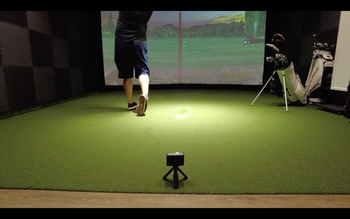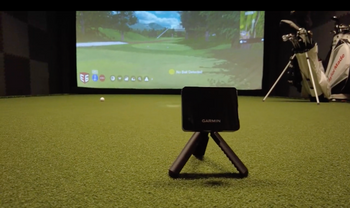You know that frustrating feeling when you're striping balls on the range but can't figure out why your 7-iron suddenly goes from 150 yards to 165? That's where launch monitors come in clutch. These high-tech gadgets track everything from how fast your ball's flying to how much it's spinning – basically all the nerdy stuff that explains why your shots do what they do.
Here's the thing, though – numbers alone won't fix your slice.
Think about it. Your launch monitor tells you the ball started 15 degrees right with 4,000 RPMs of sidespin. Cool, but what actually caused that? Did you come over the top? Was your face wide open? Without seeing your swing, you're just guessing.
That's where video changes everything. When you can actually watch yourself swing, those mystery numbers suddenly make perfect sense. Maybe you'll spot that early extension that's been killing your compression, or catch yourself flipping at the ball when you thought you were hitting down.
Getting both your swing on video and your shot data from a launch monitor? That's like having a tour coach in your pocket. You'll see exactly how that chicken wing follow-through is costing you 20 yards, or how tucking your elbow finally got you that baby draw you've been chasing.
Here's the catch – plenty of launch monitors out there will give you all the data in the world, but they won't show you a single frame of your actual swing.
Table of Contents
Integrate Video Analysis Into Your Golf Routine
You know how recording your swing can totally change your game? Well, not every launch monitor out there actually lets you do it. Between the extra cost, tech challenges, and needing solid app integration, plenty of companies skip this feature entirely. But the ones that nail it? They're game-changers.
Let's talk about the standouts that'll capture your swing while tracking your numbers.
The Full Swing KIT lives up to its name and then some. This thing captures your entire motion with a gorgeous 4K camera - we're talking movie-quality footage of your swing here. You'll see every detail crystal clear. What makes it even better is how simple it is to share clips with your instructor or buddies. You can draw lines and angles right on the video to break down what's happening. If you're working with a coach or trying to fix something specific, this visual feedback is gold.
FlightScope's Mevo+ brings serious versatility to the table. Sure, it tracks a ton of data with spot-on accuracy, but the video features are what'll blow your mind. The built-in camera grabs down-the-line footage, but here's where it gets interesting - you can hook up three more cameras for different angles. Imagine seeing your swing from multiple perspectives at once. The app makes it super easy to mark up your videos with lines and circles, too. Perfect for those "aha" moments when you finally spot what's been throwing off your tempo.
At just $699.99, the Rapsodo MLM2PRO packs two cameras into one unit. Think about that - you get full swing recording plus a slow-motion close-up of impact. No other launch monitor in this price range offers dual cameras. Since it's so portable, you can easily grab swing videos during range sessions or even mid-round. That impact camera is clutch for checking your strike quality - you'll finally see if you're hitting it thin or catching it pure.
Garmin's new Approach R50 might be the hottest tech drop of 2024, and the auto slow-mo impact replays are just part of why. Unlike the MLM2PRO, you can watch those impact videos instantly on the R50's huge 10-inch screen - no phone needed. This feature alone would be impressive, but combined with everything else the R50 offers, it's easy to see why everyone's raving about it.
Now, some launch monitors don't have cameras built in, but they'll play nice with external ones. You won't get automatic recording, but you can still sync up video with your shot data if you're willing to do a bit of setup.
Take the Garmin Approach R10 - no camera inside, but it comes with a slick phone mount that clips right on. Just use your smartphone to record, and boom, your videos show up in Garmin's app alongside all your launch data. For the price, this workaround is actually pretty sweet.
Foresight Sports takes a similar approach with their whole lineup. Whether you're looking at the GC3, GCQuad, QuadMAX, or Bushnell Launch Pro, none have built-in cameras. But hook up some external cameras and the right software, and you can sync your swing videos with all that precise shot data Foresight is famous for. It's an extra step, but if you're already invested in their ecosystem, it works great.
The SkyTrak+ follows the same playbook as Foresight. No camera onboard, but third-party software lets you match up videos from your own camera with the SkyTrak+'s data. If you've already got a decent camera setup, this could save you some cash while still getting that video analysis you're after.

Top Golf Launch Monitors and Simulators With Built-In Swing Cameras
You know how we're always trying to figure out what's going wrong with our swings? Well, capturing your swing on video gives you two killer angles to work with. You've got your wide shot that shows everything from takeaway to follow-through, and then there's that money shot - the tight zoom right where your club meets the ball.
Here's the thing - you're gonna want both angles in your back pocket. The wide view? That's your go-to when you're checking if you're swaying off the ball or if your shoulder turn looks more like a shoulder shrug. It's perfect for seeing the big picture stuff that's messing with your consistency.
Swing Path Versus Impact Zone – Which Matters Most for Video Feedback?
You know how you're always trying to nail down that perfect rhythm in your swing? Or maybe you're that guy who's constantly battling an over-the-top move? Well, if you're serious about fixing those swing gremlins, you need to actually see what's happening during your full swing.
This is where something like the FlightScope Mevo+ becomes your best friend. Picture this - you're hitting balls and getting instant feedback on what your club and body are doing through impact. The real magic happens when you hook up some extra cameras to it. Now you're getting your swing from down-the-line and face-on views, just like what your pro sees during lessons.
But here's where it gets really cool. The Full Swing KIT takes things up a notch with its crazy-clear 4K video quality. I'm talking about footage so crisp you can see exactly where your trail elbow is at the top of your backswing. And get this - you can slow that video down to a crawl. Want to check if you're casting the club? Boom, slow it down and watch frame by frame. Trying to shape out your downswing? You'll see exactly when things go sideways.
What makes this setup killer for us weekend warriors is that it shows you stuff you'd never feel on your own. Your buddy might tell you that you're swaying off the ball, but until you see it in slow-mo HD, it doesn't really click. Plus, when you're working on tricky stuff like transition timing or keeping that shaft on plane, you need more than just feels - you need proof that what you think you're doing matches reality.
The only downside? This level of detail can be a rabbit hole. You might find yourself obsessing over every tiny move instead of just making solid contact. But if you're already shooting in the 80s and 90s and want to break through to the next level, seeing your swing this clearly is like having a teaching pro in your pocket.
Deep Dive Into Your Full Swing Mechanics
Let's be honest - you can have the prettiest swing in the world, but if you're not hitting the ball flush, what's the point?
Getting a clear view of what happens when club meets ball is like turning on the lights in a dark room. You might discover you're catching the turf right before the ball, just enough to kill your distance. Maybe your clubface is a hair shut, explaining those annoying hooks you've been fighting.
Once you understand these tiny details at impact, your ball flight suddenly makes sense. Those low bullets when you wanted a high draw? The pushes when you swore you aimed left? It all becomes crystal clear, and fixing it gets way simpler.
Here's where the Garmin Approach R50 becomes your secret weapon. Picture this: you're getting tour-level data about your swing while watching HD video of your impact position right on the screen. No more guessing about what went wrong - you're seeing it happen in real-time.
The combination is killer. You get precise measurements of everything from ball speed to spin rate, plus actual footage showing whether you're hitting it thin, fat, or pure. It's like having a pro instructor and a tech guru rolled into one device sitting next to you at the range.
For us weekend warriors trying to break 80 (or 90, no judgment), this kind of feedback is gold. You'll finally know if that new swing thought is actually helping or if you're just fooling yourself. And when you start flushing more shots, your confidence goes through the roof, which we all know is half the battle in this crazy game.

Why Swing Videos From Launch Monitors Transform Your Golf Game
You know that frustration when your pro tells you what you're doing wrong, but you can't feel it? That's where video changes everything. Recording your swing while you practice isn't some fancy tour player thing anymore - it's become the secret weapon for regular golfers who actually want to get better.
Let me break down why this works so well. First off, those launch monitor numbers finally make sense when you can see what you're doing. Your monitor might show a -5 degree club path (that's coming from outside-to-in), but when you watch yourself on video? Boom - there's that over-the-top move causing all those slices. The data tells you what's happening, but the video shows you why.
You become your own swing coach between lessons. Think about it - you're hitting balls anyway, so why not record yourself and actually learn something? You'll start noticing patterns, like how you always stand up through impact when you're tired. Some monitors even let you send videos to your instructor, so they can check your progress without you driving across town.
Here's what's really cool - watching your good swings on repeat actually helps you groove them. It's like your brain creates a blueprint of what "right" feels like. When you nail that perfect 7-iron and watch it back, you're programming your body to repeat that motion. Way more effective than just hoping you'll randomly do it again.
The confidence factor is huge, too. Ever stand over a shot wondering if your backswing is too long? When you've seen yourself strike it with that same swing fifty times on video, those doubts disappear. You trust your mechanics because you've literally watched them work.
Look, it's not magic - you still have to put in the work. And yeah, some people get too caught up analyzing every frame instead of just playing. But if you're serious about dropping strokes and you're already investing in a launch monitor, adding video capability is a no-brainer. It turns those range sessions from mindless ball-beating into actual improvement time.
Combining Swing Footage and Data for Maximum Improvement
You know that feeling when you're hitting balls at the range and can't figure out why your shots keep slicing? Well, combining launch monitor numbers with actual swing footage might just be your ticket to finally fixing those issues.
Think about it - seeing your club path data is helpful, but watching your actual swing while those numbers pop up? That's when the lightbulb moments happen. You'll spot exactly why your attack angle's off or why you're losing distance on your drives. It's like having a coach break down your swing in slow motion, except you can do it yourself.
Here's the thing, though - you can't just grab any launch monitor and expect it to record your swing. Some units track your ball flight perfectly but won't capture a single frame of video.
Don't get fooled by the tech jargon either. When manufacturers talk about "photometric" or "camera-based" systems, they're describing how the device tracks your ball, either using cameras or radar technology. That's totally different from whether it'll actually film your swing. Both types can include video recording, but plenty don't bother with it at all.
Before you drop serious cash on a launch monitor, double-check what you're actually getting. Ask specifically about video capabilities - does it capture your full swing, just impact, or nothing at all? Additionally, consider how the launch monitor provides feedback and whether it integrates with any software for analysis. A comprehensive square golf launch monitor overview will help you understand the essential features and metrics offered. Make sure it aligns with your goals, whether you're looking for detailed performance insights or simply a tool to track your progress. Also, it can be beneficial to conduct a golf launch monitor comparison to see how different models stack up against each other in terms of features, accuracy, and price. This will not only help you make an informed decision but also ensure that you select a model that best fits your specific training needs. Remember, investing in the right technology can significantly enhance your practice sessions and overall game performance.
Trust me, if you're looking to shave strokes off your handicap (and who isn't?), having that visual feedback alongside your launch data makes a world of difference. The units mentioned here represent solid options that'll give you both the numbers and the visuals you need to start making real improvements.





